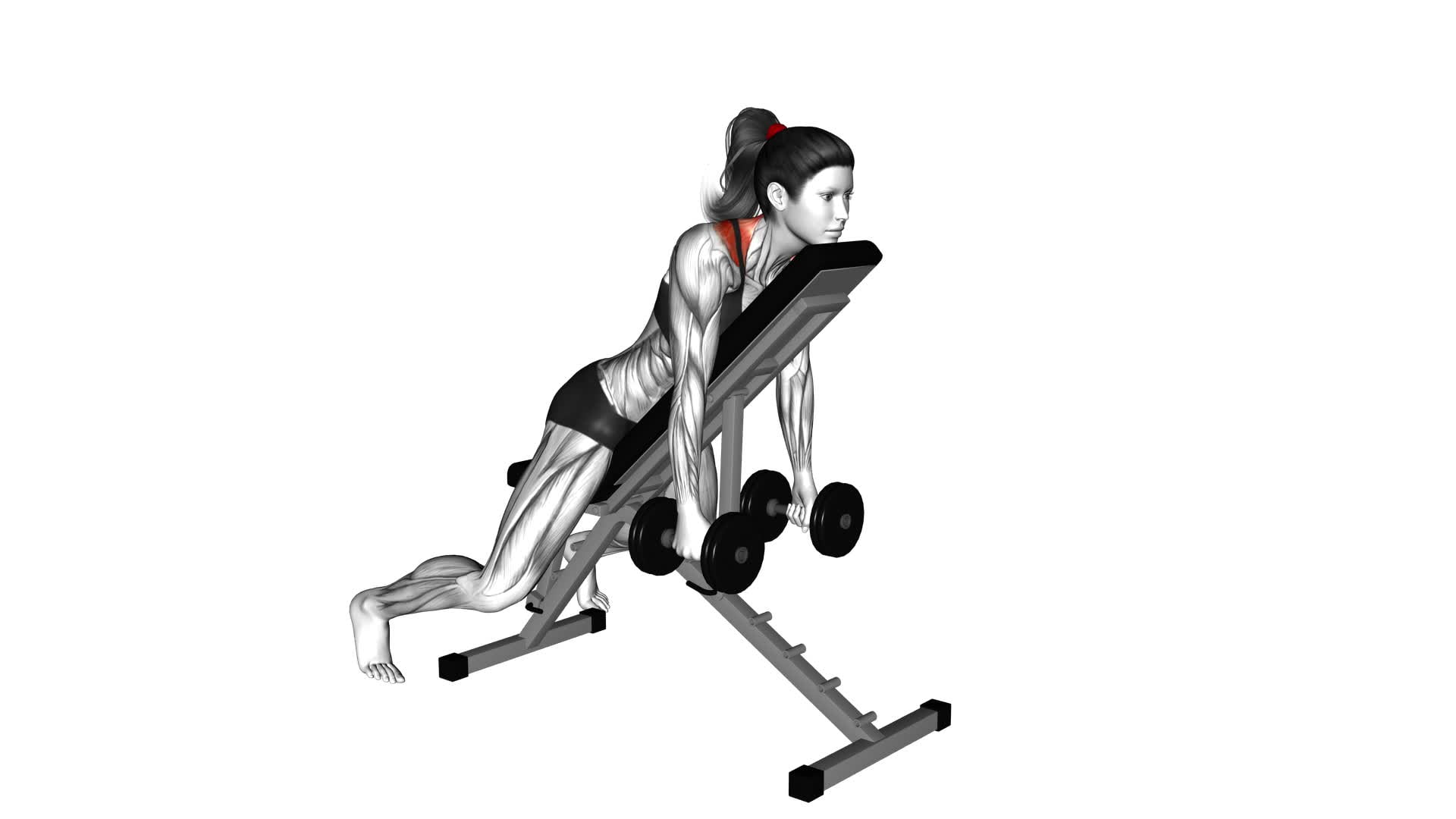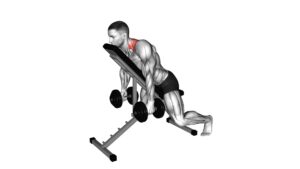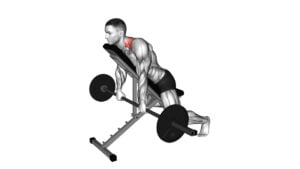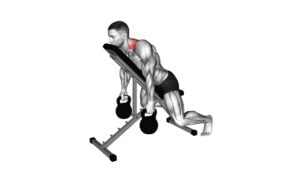Dumbbell Decline Shrug (female) – Video Exercise Guide & Tips

Looking to strengthen and tone your upper back and shoulders? The dumbbell decline shrug is the perfect exercise for you!
Watch This Exercise Video
In this video exercise guide, we'll show you the proper technique and provide helpful tips to maximize your results.
Whether you're a beginner or advanced, this exercise can be modified to suit your fitness level.
So grab your dumbbells and get ready to sculpt those muscles!
Key Takeaways
- Targets upper body strength, specifically trapezius muscles
- Develops stronger and more defined shoulders and upper back
- Improves posture by pulling shoulders back
- Contributes to better shoulder stability
Benefits of the Dumbbell Decline Shrug
You can experience many benefits from incorporating the Dumbbell Decline Shrug into your fitness routine. This weightlifting exercise primarily targets your upper body strength, particularly your trapezius muscles. By performing the Dumbbell Decline Shrug regularly, you can develop stronger and more defined shoulders and upper back.
One of the main benefits of this exercise is enhanced upper body strength. As you lift and lower the dumbbells while in a declined position, your trapezius muscles are heavily engaged. This helps to increase their strength and endurance, allowing you to handle heavier weights and perform other upper body exercises more effectively.
Additionally, the Dumbbell Decline Shrug helps to improve your posture. As the exercise targets your upper back muscles, it helps to pull your shoulders back, counteracting the slouched posture that many people develop from sitting for extended periods of time. By strengthening these muscles, you can improve your overall posture and reduce the risk of developing back pain.
Incorporating the Dumbbell Decline Shrug into your fitness routine can also contribute to better shoulder stability. The exercise specifically targets the muscles surrounding your shoulder joint, helping to strengthen and stabilize it. This can be beneficial for athletes who participate in sports that require overhead movements, such as throwing or lifting.
Proper Technique for the Dumbbell Decline Shrug
To perform the Dumbbell Decline Shrug with proper technique, start by positioning yourself on a decline bench with a set of dumbbells in each hand. Lie on the bench with your feet secured under the foot pads. Hold the dumbbells at your sides, palms facing inward. This is your starting position.
To begin the exercise, exhale and raise your shoulders up toward your ears in a shrugging motion. Hold the contraction for a brief pause at the top. Inhale and slowly lower the dumbbells back to the starting position. Repeat for the desired number of repetitions.
When performing the Dumbbell Decline Shrug, it's important to maintain proper form. Keep your back flat against the bench throughout the exercise to avoid straining your lower back. Focus on using your shoulder muscles to lift the weight, rather than using momentum or other parts of your body.
The Dumbbell Decline Shrug primarily targets the trapezius muscles, which are located in the upper back and neck area. It also engages the rhomboids, deltoids, and levator scapulae muscles. This exercise can help improve posture, strengthen the upper back, and increase shoulder stability.
Remember to start with lighter weights and gradually increase the resistance as you become more comfortable with the exercise. Always consult with a qualified fitness professional before attempting new exercises, especially if you have any existing injuries or conditions.
Common Mistakes to Avoid
Avoid slouching during the Dumbbell Decline Shrug to maintain proper form and maximize the effectiveness of the exercise. Slouching can lead to incorrect muscle activation and potential strain on the neck and shoulders. To ensure you're performing the exercise correctly, keep these common mistakes in mind:
- Rounding the shoulders: Keep your shoulders back and down throughout the movement. This helps engage the target muscles and prevents unnecessary strain on the upper body.
- Using excessive weight: It's important to use a weight that challenges you without compromising your form. Using too much weight can lead to improper technique and increase the risk of injury.
- Lifting the weights too high: The purpose of the Dumbbell Decline Shrug is to focus on the lower trapezius muscles. Avoid lifting the weights too high, as this can shift the emphasis onto other muscle groups and reduce the effectiveness of the exercise.
Variations and Modifications for Different Fitness Levels
To modify the Dumbbell Decline Shrug for different fitness levels, adjust the weight and repetition range according to your strength and experience. Beginners should start with lighter weights and focus on proper form and technique. Gradually increase the weight as you become more comfortable and confident with the exercise. Aim for a repetition range of 8-12 to build strength and muscle endurance.
For advanced modifications, you can increase the weight and perform the exercise with a slower tempo. This will increase the intensity and challenge your muscles even more. You can also try incorporating pauses at the top of the movement to further engage your shoulder and upper back muscles.
Another advanced modification is to perform the exercise unilaterally, using one dumbbell at a time. This will require greater stability and focus on each side of your body separately.
Remember to always listen to your body and adjust the weight and intensity according to your own capabilities. It's important to challenge yourself, but also to prioritize safety and proper form. With consistent practice and progression, you can continue to push yourself and achieve your fitness goals.
Tips for Incorporating the Dumbbell Decline Shrug Into Your Workout Routine
To incorporate the Dumbbell Decline Shrug into your workout routine, start by choosing an appropriate weight and repetition range based on your fitness level and goals.
Here are some tips to help you effectively incorporate this exercise into your routine:
- Warm up: Before starting the Dumbbell Decline Shrug, make sure to warm up your shoulders and upper back with some dynamic stretches or light shoulder exercises.
- Proper form: Maintain proper form throughout the exercise to maximize its effectiveness and avoid injury. Keep your back straight, shoulders back, and core engaged.
- Progressive overload: As you become more comfortable with the exercise, gradually increase the weight and/or repetitions to challenge your muscles and continue making progress.
In addition to incorporating the Dumbbell Decline Shrug, there are other exercises you can include in your routine to strengthen your shoulders:
- Shoulder press: This exercise targets the deltoids and can be performed with dumbbells or a barbell.
- Lateral raises: Lateral raises help to isolate the side delts and can be done with dumbbells or resistance bands.
- Front raises: Front raises target the front delts and can be performed with dumbbells or a barbell.
Frequently Asked Questions
How Many Sets and Reps Should I Do for the Dumbbell Decline Shrug?
For the dumbbell decline shrug, it's important to find the optimal weight and progression that challenge you without sacrificing form. Start with a weight that allows you to perform 10-12 reps with proper technique. Aim for 3-4 sets, resting 1-2 minutes between sets.
Gradually increase the weight as you get stronger. Avoid common mistakes like rounding your shoulders or using momentum to lift the weights. Focus on controlled and deliberate movements for maximum effectiveness.
Can Men Also Perform the Dumbbell Decline Shrug Exercise?
Yes, men can definitely perform the dumbbell decline shrug exercise. It's a great way to target and strengthen your upper back muscles, improve posture, and enhance shoulder stability.
By incorporating this exercise into your workout routine, you can experience improved overall strength and muscle development.
Additionally, there are various modifications and variations of the dumbbell decline shrug that you can try to challenge yourself and target different muscle groups.
Is the Dumbbell Decline Shrug Suitable for Beginners?
The dumbbell decline shrug may not be the best choice for beginners. It requires a certain level of strength and stability. If you're just starting out, there are alternative exercises you can try, like the seated dumbbell shrug or the cable shrug.
These exercises are easier to perform and can help you build up the necessary strength. Remember to avoid common mistakes like using too much weight or shrugging your shoulders too high.
What Muscles Does the Dumbbell Decline Shrug Target?
The dumbbell decline shrug is a great exercise to target multiple muscles in your upper body. By incorporating this exercise into your workout routine, you can benefit from improved shoulder and upper back strength.
To perform this exercise properly, make sure to maintain proper form and technique. Keep your core engaged, shoulders relaxed, and lift the dumbbells using your shoulder blades.
This exercise can be a valuable addition to your routine for building upper body strength and stability.
Can I Use a Barbell Instead of Dumbbells for the Dumbbell Decline Shrug?
Yes, you can use a barbell instead of dumbbells for the dumbbell decline shrug. Using a barbell has its pros and cons.
It allows you to lift heavier weights and engage more muscles, but it may also put more strain on your wrists.
If you're looking for alternatives, there are plenty of exercises that target the same muscles and provide a full body workout, such as the barbell shrug or the upright row.
Conclusion
The dumbbell decline shrug is a beneficial exercise for females looking to strengthen their upper body and improve posture. By properly performing this exercise and avoiding common mistakes, you can maximize its effectiveness.
Additionally, there are variations and modifications available for different fitness levels, making it a versatile workout option.
Incorporating the dumbbell decline shrug into your routine can help you achieve your fitness goals and enhance your overall strength and stability.

Author
Years ago, the spark of my life’s passion ignited in my mind the moment I stepped into the local gym for the first time. The inaugural bead of perspiration, the initial endeavor, the very first surge of endorphins, and a sense of pride that washed over me post-workout marked the beginning of my deep-seated interest in strength sports, fitness, and sports nutrition. This very curiosity blossomed rapidly into a profound fascination, propelling me to earn a Master’s degree in Physical Education from the Academy of Physical Education in Krakow, followed by a Sports Manager diploma from the Jagiellonian University. My journey of growth led me to gain more specialized qualifications, such as being a certified personal trainer with a focus on sports dietetics, a lifeguard, and an instructor for wellness and corrective gymnastics. Theoretical knowledge paired seamlessly with practical experience, reinforcing my belief that the transformation of individuals under my guidance was also a reflection of my personal growth. This belief holds true even today. Each day, I strive to push the boundaries and explore new realms. These realms gently elevate me to greater heights. The unique combination of passion for my field and the continuous quest for growth fuels my drive to break new ground.







